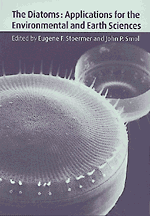Book contents
- Frontmatter
- Contents
- Contributors
- Preface
- Part I Introduction
- Part II Diatoms as indicators of environmental change in flowing waters and lakes
- 2 Assessing environmental conditions in rivers and streams with diatoms
- 3 Diatoms as indicators of hydrologic and climatic change in saline lakes
- 4 Diatoms as mediators of biogeochemical silica depletion in the Laurentian Great Lakes
- 5 Diatoms as indicators of surface water acidity
- 6 Diatoms as indicators of lake eutrophication
- 7 Continental diatoms as indicators of long-term environmental change
- 8 Diatoms as indicators of water level change in freshwater lakes
- Part III Diatoms as indicators in extreme environments
- Part IV Diatoms as indicators in marine and estuarine environments
- Part V Other applications
- Part VI Conclusions
- Glossary, and acronyms
- Index
6 - Diatoms as indicators of lake eutrophication
Published online by Cambridge University Press: 16 January 2010
- Frontmatter
- Contents
- Contributors
- Preface
- Part I Introduction
- Part II Diatoms as indicators of environmental change in flowing waters and lakes
- 2 Assessing environmental conditions in rivers and streams with diatoms
- 3 Diatoms as indicators of hydrologic and climatic change in saline lakes
- 4 Diatoms as mediators of biogeochemical silica depletion in the Laurentian Great Lakes
- 5 Diatoms as indicators of surface water acidity
- 6 Diatoms as indicators of lake eutrophication
- 7 Continental diatoms as indicators of long-term environmental change
- 8 Diatoms as indicators of water level change in freshwater lakes
- Part III Diatoms as indicators in extreme environments
- Part IV Diatoms as indicators in marine and estuarine environments
- Part V Other applications
- Part VI Conclusions
- Glossary, and acronyms
- Index
Summary
Introduction
Eutrophication refers to enrichment of aquatic systems by inorganic plant nutrients (Wetzel, 1983; Mason, 1991). Lake eutrophication occurs when nutrient supplies, usually phosphorus (P) and nitrogen (N), are elevated over rates that occur in the absence of any system perturbation, and results in increased lake productivity. Causes of eutrophication include human (anthropogenic eutrophication) and non-human (natural eutrophication) disturbances. Marked natural eutrophication events are rare and may result from dramatic episodes, such as forest fire (e.g., Hickman et al., 1990) and tree die-off (Boucherle et al., 1986; Hall & Smol, 1993). Climatic shifts, such as droughts, may also concentrate lakewater nutrients or give rise to an increased contribution of nutrient-rich groundwater (e.g., Webster et al., 1996). In most cases, however, water-quality problems are caused by anthropogenic nutrient inputs from domestic and industrial sewage disposal, farming activities and soil erosion.
Eutrophication is the most widespread form of lake pollution on a global scale, and has many deleterious impacts on aquatic systems (Harper, 1992). In addition to increasing overall primary production, eutrophication causes considerable changes to biochemical cycles and biological communities. Marked changes occur at all levels in the food web and entire communities can change or die out. For example, changes in the ratio of N:P often results in primary production shifting from primarily diatoms and other smaller edible algae towards larger cyanobacteria that are better competitors for N (Tilman et al., 1986), and more resistant to grazing (Reynolds, 1984).
- Type
- Chapter
- Information
- The DiatomsApplications for the Environmental and Earth Sciences, pp. 128 - 168Publisher: Cambridge University PressPrint publication year: 1999
- 91
- Cited by



